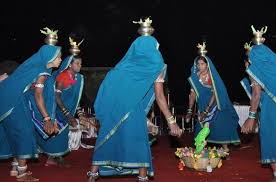
Sua song
Sua refers to a bird called parrot and the song Sua is the dance song of the original Gond tribal women which only women sing. It is sung throughout Chhattisgarh from the east of Deepawali which runs according to different traditions up to Devotthan (Jethuni) Ekadashi. This period of singing Suva songs is the period between the arrival of paddy crop in the barns and the maturity of those crops where agricultural work gives a little rest to the people of agriculture. Although the scholars believe that it was originally a dance song of the tribals, but it has been adopted by women of every class and caste in Chhattisgarh for the past several decades. It begins in the year with the Gaura festival of marriage of Shankar and Parvati at the time of Deepawali which lasts till the end of the month of Aghan (December-January).
In relation to Suva, Dr. Jagdish Kuldeep writes in his research treatise Sua Geetaru of Chhattisgarh.
Suva is a domestic animal that quickly acquires the language of humans. He has the ability to accept human voice and emotion very easily. Suva can be taught and taught with little effort. It is not only beautiful and simple, but also becomes a partner of happiness, sorrow, joy and sadness of the female mind. Since ancient times, Sua has lived with man in his home and family. Due to constant human interaction, he becomes the companion and candidate and partner of human sensations.
Similarly, in one of his articles, Dr. Ramakant Soni Ji says:
Although the Sua sings an ocean of compassion in folk dances, its folk dance song shows the diverse life colors of nature, glimpses of agricultural life, spirituality, humor with humor, variety of cool juices. That is, Suva Geet is a philosophy of life of the women of Chhattisgarh, which includes the coincidence of labor, the disconnection of the beloved, the sense stream of anomaly. In this way we find that in Suva folk dance, Chhattisgarh's folk life is vibrant.
Regarding the antiquity of Suva Geet and other cultural traditions of Chhattisgarh, scholars even say that it has existed in Chhattisgarh since Mahanadi Valley Civilization period. In one of his articles, the late Hari Thakur Ji says that
Who knows how ancient this song is? But it is certain that these songs are as ancient as the emotions prevailing in them. It is also possible that Kalidas and Jayasi have taken inspiration from these songs. These songs are still unwritten even today, and are passed on from generation to generation. From Raigad to Kanker and from Suraipali to Dongargarh, Suva song is scattered in its various forms.
In traditional Indian Sanskrit-Hindi literature, shuk (parrot) has been the main place as a carrier carrying messages between lovers and lovers. Due to the quality of copying the dialects of human beings and that have been kept in the house for centuries, it is considered to be the favorite of girls and women. By believing this bird to be a witness in imitating the dialect of man, by calling it 'Tari Nari Naha Na Ri Nahna, Re Suva Na, Kahi Aate Piya La Sandes', Viogini Nari continued to satisfy her according to these folk songs that her message Reaching her husband-lover. Over time, the message of the women through the Sua was sung as songs and symbolically the Sua took the form of a green parrot made of clay, along with its lyrical dance.
The Sua dance song is sung and danced in groups by Kumari girls and married women. According to the tradition of this dance song, paddy is placed in a basket made of bamboo, and a decorated suva made of clay is placed on it. It is popularly believed that this suva pair in the basket are symbols of Shankar and Parvati.
Dr. Jeevan Yadu Rahi writes this further clarifying
There are two idols of parrot in a basket filled with paddy. Women sing the Sua song by addressing them. The girl holding the basket on her head is called Suggy. Sua Geet is so beloved in the world, there is no caste bond in it. Women of all castes participate in the Sua dance, thus it does not seem appropriate to consider the Sua song as a dance of any particular caste.
Suva dance is usually initiated in evening. Women gather at a certain place in the village where this basket is covered with red cloth. After lifting the basket in the head, one of the women of the team walks in and puts it in the middle of the courtyard of the farmers' house. The women of the party are round about him. The cloth is removed from the basket and the lamp is lit and danced. In Chhattisgarh, no instruments are used in this song dance. The song is sung by women in applause. In some villages, women keep a wooden block in their hands to intensify the tone. Chhattisgarh, an Assamese, who went to Assam a hundred years before Chhattisgarh, is also adopting this dance song tradition, although he uses the mandar instrument in the Suva dance song that the male player plays.
In ancient tradition, when women went to the Suva Geet to go home to the farmers in the village, they were given money or grain as a gift for the dance that they used to celebrate in the marriage of Gaura-Gauri. It is worth noting here that Gaura-Gauri was then married to the amount collected as a gift from Suva dance, which makes it clear that Suva dance starts before Diwali. Traditionally to do suva dance
